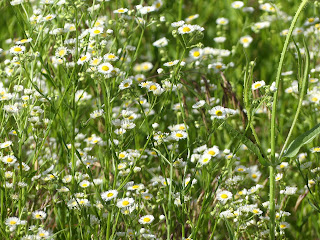Fleabane Meadow
Here's a meadow that, as best as I can determine, was dominated in June by wildflowers called fleabanes. In the first picture you can see the wildflowers fairly well; in the second picture you can see just how much of it was growing out there. (It's difficult to be certain that all that white was the same type of wildflower, though based on what I could see I'm pretty sure the vast majority of it was the same plant.)
There are a few different fleabanes kicking around central NJ. I'm suspicious these are Prairie Fleabanes (aka Lesser Daisy Fleabanes) since this species is known to live on the property. My picture doesn't give a great view of the leaves, but individual leaves would clasp (have a connection all around) to the stem in a Philadelphia Fleabane (aka Common Fleabane). The Eastern Daisy Fleabane is a more subtle species to differentiate from the Prairie Fleabane; the Eastern Daisy Fleabane is more likely to have toothed leaves, generally looks leafier, has a hairier stem, and can grow taller. Some asters can look similar, though they should have 40 or fewer flower rays.
I will say that I was surprised to see a native wildflower dominate a meadow like this. Sometimes an invasive plant that nothing around here will eat will create a monoculture, but with the exception of goldenrods I don't often see native plants that are able to do this. I was wondering if Duke Farms helped this along by seeding it. If so, I suspect these fleabanes to show up next year, but with a few other wildflowers starting to move in too. As a native wildflower, it's easy to think that pollinators and seed eaters took advantage of the bounty regardless of exactly how it came to be.
Fleabanes were named due to the belief that the leaves could be used as a flea repellant or flea insecticide, though it's unclear that this actually works. (On the other hand, I do have to acknowledge that I did not have fleas after leaving this meadow.)





Comments
Post a Comment